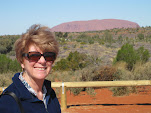John told us the local people like to swim in these areas since the tourists like to hang around the white sandy beaches. This way the locals get some privacy.
During the late 1600's and early 1700's some locals mostly due to starvation fell to cannibalism. Those that did were sent to this cave. Not much of a way out of there.
We stopped for a beautiful overlook. The town of Hanga Roa is in the distance. In between the trees and the town you can see the air strip that we landed on. One plane comes in each day. Monday there are two planes, one of which goes on to Tahiti. The strip was originally built by NASA as a back up landing strip in the middle of the South Pacific for the shuttle program.
When the British came to the island they brought sheep, eucalyptus trees, and fenced all the islanders into the Hanga Roa area. The sheep, British, and the fence are now gone.
Us at the crater.
Today's big history lesson was the story of the Birdman Competition. After years of fighting amongst themselves - Moai tipping, murder, and the like - a king had a brilliant idea. He decided to eliminate the Moai ancestor worship and to bring in a competition. The Petrogliff below shows a birdman depiction. Bird's head to the right (beak upwards) man's arms upward and legs to the left.
For centuries in the spring around here (September) Sooty Terns would land on the largest of the little islets in the photo below. Seven clans would come to Orongo (site of the competition) and wait for a birds to land on the islet. When the birds would take off for food, the competition was on...
Us at Orongo
Housing for the contestants and their entourage. A chief, a priest, and two other warriors who came along, just in case.
The contestants and to first climb down the cliff face that was a wall of the volcano. They then had to swim to the islet, find a tern egg, stick it on a headdress so he could swim back to shore. The swim is about 1400 m, but they did have reed floaters to help them. The first person to do all of this became leader of all the clans for a year. The head birdman.
We then went back to the hotel, had a great lunch, then hit the road around 2:30. Our first stop was Puna Pau. It is a quarry for the red, volcanic tuff (a welded volcanic ash) that was used for the topknots on the Moai's.
Above is an abandoned topknot.
The Puno Kau quarry.
Our next stop was Ahu Akivi. These Moai were different in several ways from the Moai we'd seen at the coasts. First of all there were seven of them sitting about in the middle of the island. They were roughly the same size, and the platform that they sat on was not filled with bones - it was purely a platform. On the day of the Fall equinox (March 21st around here) the sun rises above the middle of the seven Moai.
The equinox Moai.
Our next stop were the Lava Tube caves at Ana Te Pahi.
John next to the sign for the caves. We had just ridden across what must have been the worst road I've ever been on. Pools of water, enormous ruts and holes, and stones of all sorts and sizes blocked the road. Good grief.
Below are a few photos from inside the cave.
We went in and out of one cave, then John asked us if we wanted to have an adventure. He said he had a flashlight. We ended up walking about 200 m in the cave - only a flashlight to see where we were going, and scrambling over damp rocks, made it a real adventure. The only places where we had to crouch was getting out of the cave at the end. I'm real brave if I can stand up in a cave.
Our last stop was Tahai, the place Charlie and I had walked to our first day out. The photo below show the Moai and in the distance behind them, is our hotel.
One more touring day - until tomorrow.



















No comments:
Post a Comment